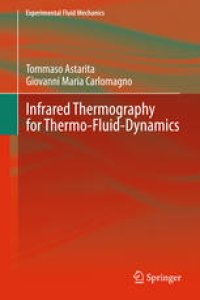
Ebook: Infrared Thermography for Thermo-Fluid-Dynamics
- Genre: Physics // Mechanics: Fluid Mechanics
- Tags: Engineering Fluid Dynamics, Measurement Science and Instrumentation, Security Science and Technology
- Series: Experimental Fluid Mechanics
- Year: 2013
- Publisher: Springer-Verlag Berlin Heidelberg
- Edition: 1
- Language: English
- pdf
Infrared thermography is a measurement technique that enables to obtain non intrusive measurements of surface temperatures. One of the interesting features of this technique is its ability to measure a full two dimensional map of the surface temperature and for this reason it has been widely used as a flow visualization technique. Since the temperature measurements can be extremely accurate it is possible, by using a heat flux sensor, also to measure convective heat transfer coefficient distributions on a surface making the technique de facto quantitative. This book, starting from the basic theory of infrared thermography and heat flux sensor guides, both the experienced researcher and the young student, in the correct application of this powerful technique to various practical problems. A significant number of examples and applications are also examined in detail.
Infrared thermography is a measurement technique that enables to obtain non intrusive measurements of surface temperatures. One of the interesting features of this technique is its ability to measure a full two dimensional map of an object surface temperature and, for this reason, it has been widely used as a surface flow visualization technique. Since the temperature measurements can be extremely accurate, it is possible, by using a heat flux sensor, also to measure convective heat transfer coefficient distributions on a surface, making the technique de facto quantitative. This book, starting from the basic theory of radiation and heat flux sensors, guides, both the experienced researcher and the young student, in the correct application of this powerful technique to study convective heat transfer problems. A significant number of examples and applications are also examined in detail, often pointing out some relevant aspects.
Infrared thermography is a measurement technique that enables to obtain non intrusive measurements of surface temperatures. One of the interesting features of this technique is its ability to measure a full two dimensional map of an object surface temperature and, for this reason, it has been widely used as a surface flow visualization technique. Since the temperature measurements can be extremely accurate, it is possible, by using a heat flux sensor, also to measure convective heat transfer coefficient distributions on a surface, making the technique de facto quantitative. This book, starting from the basic theory of radiation and heat flux sensors, guides, both the experienced researcher and the young student, in the correct application of this powerful technique to study convective heat transfer problems. A significant number of examples and applications are also examined in detail, often pointing out some relevant aspects.
Content:
Front Matter....Pages i-xxii
Introduction and historical grounding....Pages 1-4
Physical background....Pages 5-21
IR Scanner....Pages 23-48
Heat Flux sensors....Pages 49-82
Restoration of thermal images....Pages 83-99
Some practical considerations....Pages 101-127
Applications....Pages 129-197
Back Matter....Pages 199-224
Infrared thermography is a measurement technique that enables to obtain non intrusive measurements of surface temperatures. One of the interesting features of this technique is its ability to measure a full two dimensional map of an object surface temperature and, for this reason, it has been widely used as a surface flow visualization technique. Since the temperature measurements can be extremely accurate, it is possible, by using a heat flux sensor, also to measure convective heat transfer coefficient distributions on a surface, making the technique de facto quantitative. This book, starting from the basic theory of radiation and heat flux sensors, guides, both the experienced researcher and the young student, in the correct application of this powerful technique to study convective heat transfer problems. A significant number of examples and applications are also examined in detail, often pointing out some relevant aspects.
Content:
Front Matter....Pages i-xxii
Introduction and historical grounding....Pages 1-4
Physical background....Pages 5-21
IR Scanner....Pages 23-48
Heat Flux sensors....Pages 49-82
Restoration of thermal images....Pages 83-99
Some practical considerations....Pages 101-127
Applications....Pages 129-197
Back Matter....Pages 199-224
....